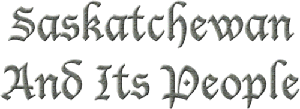THE LISTER KAYE FARMS. (con't)
Settlers were to be provided with ready made houses, 20 acres broken
and stock. The land was selected by a "British expert" and was to be
run on British methods.
Here we get another big germ of the inevitable failure. Fancy apply-
ing the methods of one country to another with a different soil and a differ-
ent climate; the methods of a moist and rainy country to a bare, sun-
scorched, open, treeless plain. Elementary common sense should have
cried out against such an absurdity.
Before we go any further we may dispose of the water-cart legend.
Many people to this day look upon it as an invented story on the green
Englishman. To put the matter beyond doubt we reproduce the following
from the North West Farmer and Miller for August, 1889:
"Sir John Lister Kaye is trying a novel experiment on his Northwest
farms. When in Winnipeg he noticed the big sprinkling carts and when
the drought threatened the crops he conceived the idea of putting a large
number in service for the purpose of supplying rain (Note -We wonder
whether he ever thought of what our friend Joe Wiley said to him in
London) and ordered from Ryan and McArthur of Winnipeg 44 tanks.
This is foul for each farm. He only ordered the tanks and sprinklers,
intending to place them on wagons which belong to the farms. It is only
for certain kinds of grain that the tanks are to be used. They are made
of pine boards with oak cross pieces, and are water-tight. They are 11
feet 4 inches by 3 feet 27 inches and are two feet high. They will hold
about twelve barrels of water each. The experiment will be watched with
interest." it takes a hundred tons of water to give one acre of thirsty
crop a good drenching, and a nice hot salubrious wind will lick that up in
three days. We mercifully refrain from further remark, except to state
that in some instances there was no creek or lake water available on the
farms, and the water had to come from by no means inexhaustible wells.
True these wells had windmills harnessed to them, but the action of the
wind had no appreciable effect on the supply of the water.
It is interesting to find "Jim" Ross (afterwards Governor of the Yu-
kon, and now senator) coming into the Lister Kaye picture. He and Mr.
William Riddell, both of Moose Jaw, went to Ontario for the worthy
baronet and bought the breeding mares for the farms. At a later date,
after the farms were established, Mr. Ross contracted to deliver 18,000
sheep from Oregon, U. S. A. These sheep were shipped by train to Fort
Assiniboine in Montana. From there to Maple Creek on the C. P. R.
where they were to be delivered for distribution, is about 150 miles. Here
we get a glimpse of another well-known public man, the same D. J. Wiley
who gave Sir John the good advice in London, for he was one of the men
who helped drive the sheep. Another man was one McTavish, a Hudson's
Bay Scotchman. It was a very dry season and there was little or no water
on the open. The sheep therefore had to be kept in touch with Willow
Creek, and that made the distance longer. Only a few sheep were lost, as
was inevitable among so many.
Bibliography follows:

